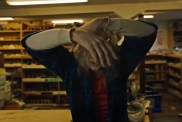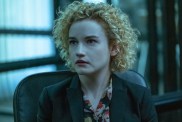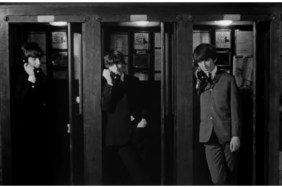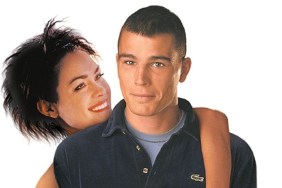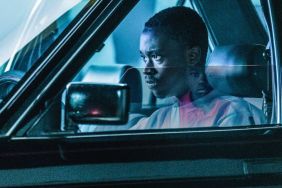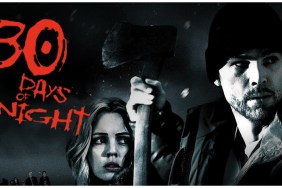Cast:
Josh Hartnett as Eben Oleson
Melissa George as Stella Oleson
Danny Huston as Marlow
Ben Foster as The Stranger
Mark Boone Junior as Beau Brower
Mark Rendall as Jake Oleson
Amber Sainsbury as Denise
Manu Bennett as Billy Kitka
Megan Franich as Iris
Joel Tobeck as Doug Hertz
Elizabeth Hawthorne as Lucy Ikos
Nathaniel Lees as Carter Davies
Craig Hall as Wilson Bulosan
Chic Littlewood as Issac Bulosan
Peter Feeney as John Riis
Directed by David Slade
Summary:
Commendable for its daring, unconventional vision of vampires, but its erratic pacing makes it a jarring experience that’s hard to adjust to, at least on first viewing.
Story:
Every year, the town of Barrow, Alaska experiences a sunless month in complete darkness and this year, a group of ancient vampires led by the ruthless Marlow (Danny Huston) have come to town with plans to prey and feed on the townspeople, forcing the sheriff Eben Oleson (Josh Hartnett) and his estranged wife Stella (Michelle George) to band together.
Analysis:
The original comic book “30 Days of Night” by Steve Niles and Ben Templesmith was such a revelation in that it helped revive the horror comics that were so prominent in the ’50s and the ’70s while also doing something different with the all-too-common world of vampires. This Sam Raimi produced movie based on the comic continues the reinvention of the horror mainstays thanks to the vision of “Hard Candy” director David Slade, but the end results may be too daring and unconventional for their own good.
The story opens and closes almost exactly like the comic book, but it’s the stuff in the middle that’s so obviously different. In this case, Eben and Stella are separated, likely driven apart by the pressures of the area’s isolation and the annual month-long darkness, but Stella’s attempt to leave Barrow before that occurs are cut short by an accident, just as odd circumstances start happening, cutting the town off from the outside even further. As gruesomely mutilated bodies start turning up, Eben realizes something is happening and it’s not long before the town is attacked by bloodthirsty vampires who have 30 days without sunlight for a non-stop feeding frenzy.
Slade takes a lot of chances with his decisions and one can commend him for being so daring when exploring the often cliché-driven vampire oeuvre, but so many of the ideas are so foreign and unconventional that it might turn off those who have gotten used to certain ideas of vampires. Much of the film’s focus is put on the characters and their relationships, which is honorable but not particularly interesting, because it slows the movie down and puts too much into the character developments, which is odd to fault when you consider how many horror movies have absolutely none. The best comparison for the movie might be a Pixies song where it’s quiet, quiet and then all of a sudden, there’s a really LOUD part and then it’s quiet some more. Except that Pixies weren’t exactly commercially viable when they first appeared, and it took some time for their audience to find them. The same can be said for Slade’s vision of vampires that scream and shriek instead of talking when they attack their victims. Most of them look like the creatures from the comics, but they don’t feel quite the same when moving in such rapid motion, creating a similar problem to the one diehard zombie fans had with the fast-moving zombies of “28 Days Later” and Zack Snyder’s “Dawn of the Dead.”
Granted, it would be nearly impossible to recreate Templesmith’s abstract art that literally looks like red paint was splattered on the page even if one were to use the CG techniques perfected to bring Frank Miller’s artwork to the screen. That said, the most effective shots are the bird’s eye views of the desolate, snow-covered town with large splotches of red where people used to be, and some of the better scenes are the ones that have been taken verbatim from the comic book.
There are some great set pieces between the vampire attacks and a climactic battle between Eben and the vampire leader Marlow, a great scenery-chewing performance by Danny Huston, looking very dapper in his blood-covered suit as he waxes poetic and philosophical in some foreign vampire language, strange in its contrast to the shrieking and grunting of the other vampires. Ben Foster is also suitably loony as a harbinger to the coming violence, but sadly, he disappears from the story leaving you wanting more of him. Josh Hartnett and Melissa George are better than your average horror movie heroes, if you can even call them that, but neither of them add very much to keep things interesting when they’re not fighting vampires.
The amount of wanton splatterific gore is commendable for this type of studio movie, although some of it looks cheap, especially when done “in camera”, reminding us of the cheesier gore effects used by producer Raimi in his early movies. The movie isn’t particularly scary either, because you’re always expecting vampires to jump out at every turn, especially after an extended quiet passage. Other odd decisions include the omission of all musical scoring in favor of loud sound effects and bizarre ambiences designed by the talented Brian Reitzell, who tends to be very musical-minded.
A bigger problem is the lack of any feeling that time is passing over the course of the movie, although we’re supposed to believe that an entire month has passed from beginning to end. The characters don’t seem to go through that much of a change in that course of time, either physically or emotionally–or they somehow find a way to shower and shave despite being trapped in hiding for most of that time–and that greatly takes away from any realism that Slade has tried to create in this fantastical situation. Also, anyone who can’t figure out what’s going to happen with that “Utilidor”, a machine with giant interlocking gears, from the second it’s introduced, probably doesn’t understand foreshadowing.
With three writers involved, including creator Steve Niles, the movie seems too much like a conglomeration of three different ideas, but much of Niles’ personality is gone from the movie with the dialogue being somewhat trite, and his distinctive narration being completely removed. Then again, the movie’s ending, also taken directly from the graphic novel, is a lovely scene that epitomizes what made the original source material so special, but it’s just not as satisfying due to some of the changes made beforehand.

